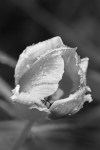Black and white photography has always been my preferred medium, and at one time I even believed it was the only way serious photographers worked. To me a black and white photograph has a mood and conveys an almost tactile quality, and because of that many of my image files, personal and professional, get converted to B&W.
During film’s reign photographers had to decide whether to use black and white film, colour film or slide film and many carried two camera bodies for that, but today the decision to make a black and white image is best left to post production; there is no need for that second camera. Post-production is the intricate combination of computer programs, printers and papers that now rivals the quality of chemical-based, traditional black and white photography.
Traditional black and white depended first on the brand and type of film, for example, Kodak Tri-X, or Ilford Delta 400, etc., then the camera’s initial exposure, how the film was developed (what chemicals were to be used), and finally the choice of paper for final printmaking.
The difference between black and white film and the digital sensor is that film has more latitude and getting a usable exposure is very easy. If one over exposes with B&W film it usually isn’t a problem, but an over exposure with digital equals a loss in image information and can end in an unusable photograph. With film we used to hear “shoot for the shadows”, with digital all that has changed; we have to be very careful not to over expose. Fortunately, we can now check our exposures using the histogram.
Most digital cameras have a black and white mode available in the menu, but I don’t recommend using that, it does nothing more than create identical red, green, and blue channels in the final picture file. Just de-saturating a colour data file in-camera will give a black and white image, but it doesn’t include control of the different tonal values that make up a black and white image.
There are however, many programs and “recipes” for image conversions very close to the quality that used to be only available from a roll of film.
When I first started making black and white pictures years ago with PhotoShop 7 I used a B&W conversion process that used the channel mixer. To do that I first opened the image, then I went to the menu and selected adjustments, then in the drop down list I selected Channel Mixer. I checked the monochrome box at bottom left, I changed the red channel to 60%, changed the green channel to 40%, ignored the blue channel, and changed the constant to +4. Finally I clicked ok and I had a black and white image.
PhotoShop CS3 and CS5 both have very good black and white mode selectors with lots of tonal control. I also suggest programs like Silver Efex Pro available from NIKsoftware.com.
However, there are excellent instructions for making B&W images from the likes of Hollywood celebrity photographer Greg Gorman, and I have tried a neat Hue/Saturation conversion I found floating around the internet by someone called Hikin’Mike. There are many more, just do a search.
A black and white photograph depends on its ability to communicate, as it doesn’t attract with eye-catching colours for its’ visual presentation. Those B&W images that stand out combine attention to lighting, composition and perspective. Black and white photography is far from being left behind in the past, and, in my opinion, with the current processing software, updates in high quality printers, and the latest in printing papers, black and white image-making will continue to be an option for serious photographers.




